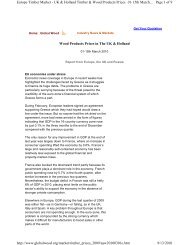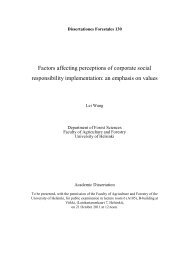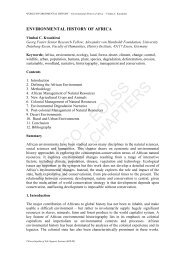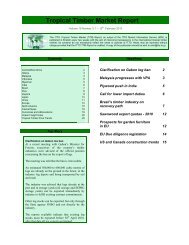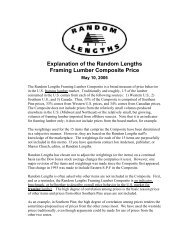ICT and e-Business in the Pulp, Paper and Paper ... - empirica
ICT and e-Business in the Pulp, Paper and Paper ... - empirica
ICT and e-Business in the Pulp, Paper and Paper ... - empirica
You also want an ePaper? Increase the reach of your titles
YUMPU automatically turns print PDFs into web optimized ePapers that Google loves.
<strong>Pulp</strong>, paper <strong>and</strong> paper products<br />
The e-<strong>Bus<strong>in</strong>ess</strong> Scoreboard 2006<br />
The e-<strong>Bus<strong>in</strong>ess</strong> Scoreboard approach was developed by e-<strong>Bus<strong>in</strong>ess</strong> W@tch <strong>in</strong> 2004. It is<br />
a compound <strong>in</strong>dex that condenses data on <strong>ICT</strong> adoption <strong>and</strong> e-bus<strong>in</strong>ess activity, enabl<strong>in</strong>g<br />
comparisons across different sectors, countries or size-b<strong>and</strong>s.<br />
Conceptually, <strong>the</strong> e-<strong>Bus<strong>in</strong>ess</strong> Scoreboard owes a debt to <strong>the</strong> Balanced Scorecard (BSC)<br />
approach, which suggests that an organisation should be viewed from four perspectives,<br />
<strong>and</strong> that metrics (<strong>and</strong> targets) are to be def<strong>in</strong>ed for each perspective. Similarly, <strong>the</strong> e-<br />
<strong>Bus<strong>in</strong>ess</strong> Scoreboard looks at <strong>ICT</strong> use by enterprises from four (<strong>in</strong>ter-related)<br />
perspectives. The Scoreboard consists of 16 component <strong>in</strong>dicators (see next page),<br />
which represent <strong>the</strong> metrics for <strong>the</strong>se perspectives. Component <strong>in</strong>dicators (CI) can be<br />
aggregated on several levels.<br />
First, CI can be aggregated<br />
<strong>in</strong>to <strong>the</strong> 4 ma<strong>in</strong><br />
sub-<strong>in</strong>dices (with 4 CI<br />
each) that represent major<br />
application areas of e-<br />
bus<strong>in</strong>ess.<br />
Second, <strong>the</strong> four sub-<strong>in</strong>dices<br />
can be fur<strong>the</strong>r aggregated<br />
<strong>in</strong>to 2 dimensions <strong>and</strong>,<br />
f<strong>in</strong>ally, <strong>in</strong>to <strong>the</strong> overall<br />
"e-<strong>Bus<strong>in</strong>ess</strong> Index".<br />
16 Component<br />
Indicators<br />
A.1 Internet<br />
A.2 LAN<br />
A.3 W-LAN<br />
A.4 Remote<br />
B.1 Intranet<br />
B.2 ERP<br />
etc.<br />
4 Sub-Indices<br />
(by bus<strong>in</strong>ess function)<br />
A. Access to<br />
<strong>ICT</strong> networks<br />
B. e-Process<br />
<strong>in</strong>tegration<br />
C. Supply-side<br />
activity<br />
D. Market<strong>in</strong>g<br />
<strong>and</strong> sales<br />
E - <strong>Bus<strong>in</strong>ess</strong><br />
Index<br />
E - <strong>Bus<strong>in</strong>ess</strong><br />
Index<br />
The e-<strong>Bus<strong>in</strong>ess</strong> Scoreboard takes <strong>in</strong>to account <strong>the</strong> percentages (diffusion rates) from all<br />
sectors (size-b<strong>and</strong>s, …) <strong>and</strong> show how a specific sector (size-b<strong>and</strong>, …) differs from <strong>the</strong><br />
all-sector-average. An <strong>in</strong>dex value is based on mean values <strong>and</strong> st<strong>and</strong>ard deviations.<br />
Thus, <strong>in</strong>dex values express <strong>the</strong> multiple of <strong>the</strong> st<strong>and</strong>ard deviation (1 or (-1)) for a specific<br />
sector <strong>and</strong> <strong>the</strong> selected <strong>in</strong>dicator. 0 equals <strong>the</strong> mean value for all sectors (size-b<strong>and</strong>s,<br />
…).<br />
Indexes simplify multi-dimensional concepts. To correctly assess <strong>the</strong> validity <strong>and</strong><br />
shortcom<strong>in</strong>gs of <strong>the</strong> Scoreboard <strong>and</strong> its overall <strong>in</strong>dex, <strong>the</strong> follow<strong>in</strong>g notes should be taken<br />
<strong>in</strong>to account:<br />
Weight<strong>in</strong>g: Results are <strong>in</strong>fluenced by <strong>the</strong> selection of <strong>the</strong> underly<strong>in</strong>g weight<strong>in</strong>g<br />
scheme for component <strong>in</strong>dicators. If employment-weighted figures are used, e-<br />
bus<strong>in</strong>ess activity <strong>in</strong> large firms is emphasized. If <strong>in</strong>dicators are weighted by <strong>the</strong><br />
number of enterprises (irrespective of <strong>the</strong>ir size), <strong>the</strong> situation <strong>in</strong> smaller firms is<br />
emphasized.<br />
Component <strong>in</strong>dicators: The selection of component <strong>in</strong>dicators may have a bias<br />
towards manufactur<strong>in</strong>g activities, as some <strong>in</strong>dicators can be more relevant for<br />
manufactur<strong>in</strong>g than for service sectors (e.g. ERP use).<br />
Relative comparison: The Scoreboard results do not represent absolute<br />
measures of e-bus<strong>in</strong>ess activity, but depend on <strong>the</strong> respective set of sectors (or<br />
countries, ...) that are compared to each o<strong>the</strong>r, because figures express st<strong>and</strong>ard<br />
deviations from <strong>the</strong> average of <strong>the</strong> respective set.<br />
191



